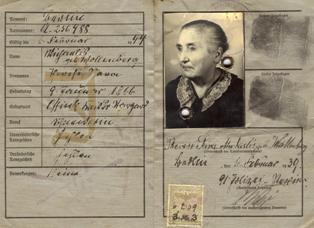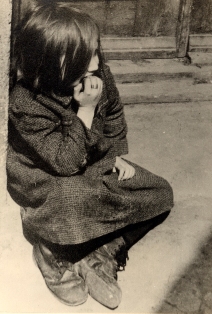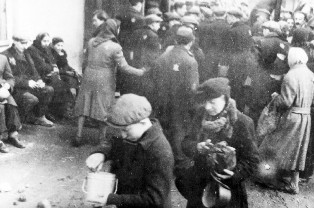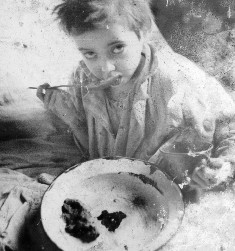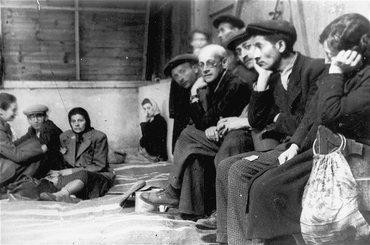Holocaust Education & Archive Research Team |
|
Ghettos The Lodz Ghetto Introduction to the Ghettos of the Holocaust
Jewish Ghettos
The Judenrat Judenrat Leaders Prominent Jews
| ||
Deportations from the Greater German Reich to the Lodz Ghetto October – November 1941
Dawid Sierakowiak wrote in his diary on 4 October 1941:
“Today Rumkowski met with all the teachers in the ghetto. He said that because 20,000 Jews are arriving from all over Germany, he is extending the school recess now, instead of having it during the winter.
I think it’s the end of schooling in the ghetto, at least for me, since I don’t think I’ll be a lyceum student, after all. “
On 16 October 1941 the first of twenty trains left Greater Germany “for the East.” By 4 November they had all completed their journey, taking 19,837 Jews to the Lodz ghetto.
One of these trains, with 512 Jews, came from Luxembourg. Five trains, with 5,000 Jews in all, came from Vienna, a similar number from Prague, and 4,187, in four trains, from Berlin. Other trains came from Cologne, Frankfurt, Hamburg and Dusseldorf.
Shlomo Frank recorded in his diary:
19 October 1941:
"Today 1,000 deportees from Vienna arrived in the ghetto. Among the new arrivals are physicians, engineers, professors, famous chemists, dental technicians, once prominent merchants, several priests from converted families, and twenty Christian women, who have come along with their husbands and children.
The Viennese Jews have brought a lot of food and other goods. They said that between Vienna and the Polish border they travelled in second –class railway cars. They were treated well. They say that most of the Viennese population sympathised with them.
Some Viennese women cried openly and asked good God to let them see each other again soon. But as soon as they entered Poland, there was a change of guards, and with it good relations ceased.
The farther they travelled the worse their treatment."
21 October 1941
Today before noon 1,050 Jews from Prague arrived in the ghetto. They were all in good spirit and replied with a friendly shalom to the greetings of the Jewish police at the Marysin station. Some comforted us with quotations from the Prophets, predicting an imminent end to the war.
22 October 1941
Today another transport of 1,200 Jews from Vienna and its surrounding towns arrived. Most are old people, many of them sick. They looked like they were taken only yesterday from hospitals and old age homes.
The transport arrived in the evening. The streets were dark and gloomy, and in this darkness the old, broken Viennese Jews marched step by step, with heavy knapsacks on their arms, dejected and oppressed.
One of them, Maurice Kellerbach, told us that among the deportees he saw a Jewish baron from Vienna. Maybe he is already here but has not revealed his identity.
23 October 1941
Today a transport of Jews arrived from Frankfurt. At their arrival four men were found missing.
The transport list showed 1,200 names, but only 1,196 were accounted for. Almost all held up well. They greeted us with a bright “Shalom, Yehudim” (Hebrew – Peace, Jews), joked, patted backs, exhorted us to preserve, not to surrender, not to despair.
“Courage lost is everything lost.”
They described dramatic scenes on the eve of the deportation from Frankfurt. German neighbours brought them cookies and other food. Some women cried. Expressions of sympathy were heard at the farewell.
Some women prayed to God that he protect the Jews and bring them back to their old home.
25 October 1941
Today 560 Jews from Luxembourg arrived at the Marysin station. They were all beside themselves with bitterness, pain and grief. They spoke of bad experiences during their trip.
They rode in guarded and locked cars. Anyone stepping out of the car was immediately punished. There were various kinds of punishment. Some had to run around the train 25 times. Others had to yell “Heil Hitler”, or “Verruchter Jude” (German – accursed Jew). And others were severely beaten.
While still in Luxembourg they were treated quite well. The population regretted that the Jews were being deported. People brought Jewish neighbours apples, dried prunes, biscuits and other food.
Some accompanied the deportees to the railroad station with tears in their eyes.
27 October 1941
Today 1,000 Jews arrived from Berlin. Almost ninety percent of them are old people who can barely stand on their feet. Many were bent over under the weight of their knapsacks.
They were allowed to take as much as they could carry. They travelled in first and second class cars up until the Polish border, then they were moved to other cars.
28 October 1941
The recent newcomers from Germany have been receiving letters from relatives still at home.
A Letter from Berlin:
“You should know that Uncle is very sick. We expect a catastrophe any day. The curfew hours have changed: Jews may remain outdoors until 5pm, Christians until 8pm. The situation here has changed very much. Your apartment is still unoccupied.”
The arrival of the “Western European Jews in the Lodz ghetto made a considerable impression: six months later, one of the ghetto chroniclers recalled their arrival:
“We were struck by their elegant sports clothes, their exquisite footwear, their furs, the many variously coloured capes the women wore. They often gave the impression of being people on some sort of vacation or, rather, engaged in winter sports, for the majority of them wore ski clothes.
You couldn’t tell there was a war on from the way those people looked; and the fact that, during the bitter cold spells they strolled about in front of the gates to their “transports” and about the city as well, demonstrated most eloquently that their layers of fat afforded them excellent protection from the cold.
Their attitude toward the extremely unsanitary conditions in which they were quartered was one of unusual disgust, though perhaps that was not without justification; they shouted, they were indignant, and beyond the reach of any argument.”
The Ghetto Chronicle also recalled the arrival of the deportees from Hamburg. They had reached the Lodz ghetto on a Thursday evening, and were housed in a former cinema.
On the Friday morning, Rumkowski called on them. “They were spread out on the floor,” the chronicle noted, “sleeping on their bundles, the old people and the women sitting in chairs lining the walls.”
That evening they arranged a Friday evening service, to welcome the Sabbath:
“Dressed in their best clothes, with many candles lit, they said their first prayer to God with uncanny calm and in a mood of exaltation. Those who had left Judaism a long time before, even those whose fathers had broken any connection with their forefathers, stood there that day, festively attired, in a sort of grave and exalted mood, seeking consolation and salvation in prayer.
When their prayers were concluded, they went out into the lobby, the same words on all their lips; “Now we see that we are all equal, all sons of the same people, all brothers.”
This was either mere flattery or, perhaps, a genuine compliment to the old population – or perhaps, a premonition of the not – too distant future.
The chronicler added, in the retrospect of six months:
“Events outpaced time, people changed visibly, at first outwardly, then physically, and finally, if they had not vanished altogether, they moved through the ghetto like ghosts.
The turnips and beets they had at first disdained, they now bought at high prices, and the soups they had scorned became the height of their dreams.
Once it had been others, but then it was they who prowled the “city” with a cup or a canteen on a chain to beg a little soup.”
May 1942 – Deportations from Lodz to Chelmno
Beginning on 4 May 1942 and continuing without pause for eleven days, more than ten thousand Jews were deported from the Lodz ghetto to Chelmno, and gassed, in the gas vans at the Palace.
These were the Jews who had been brought to Lodz from Western Europe six months earlier.
The Chronicle of the Lodz Ghetto recorded the deportations:
“On Monday at around 8.00am the first transport of the Western European Jews, who are being resettled after being settled in the ghetto half a year ago, pulled out of the Radogoszcz sidetrack station.
At the moment, one important detail has been established in connection with the departure of the first transport: all those departing (the transport consisted of one thousand people) had their luggage, knapsacks, and even their hand held parcels taken away from them.
The news has cast a chill over the ghetto.”
Sources:
Lodz Ghetto – Inside A Community Under Siege – by Alan Adelson and Robert Lapides, published by Viking Penguin 1989. The Holocaust by Sir Martin Gilbert, published by Collins London 1986. The Chronicle of the Lodz Ghetto 1941-1944 edited by Lucjan Dobroszycki, published by the Yale University Press, New Haven & London 1984. Holocaust Historical Society
Special thanks to Robin S.
Copyright Chris Webb H.E.A.R.T 2008
|


